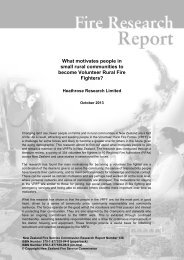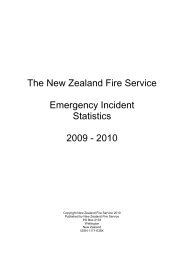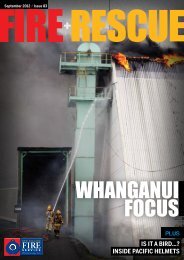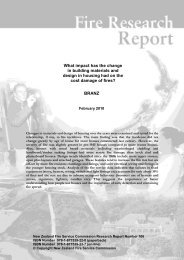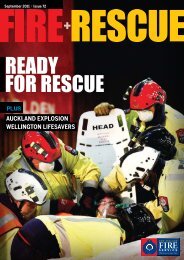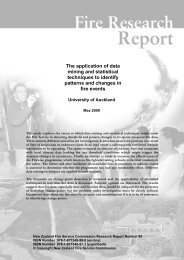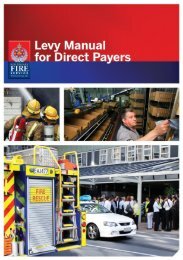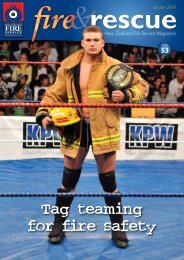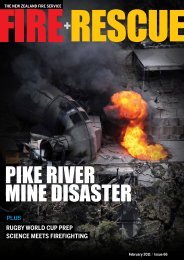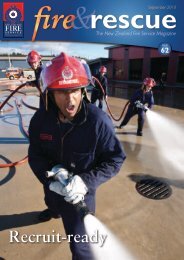FIRE BOMB - New Zealand Fire Service
FIRE BOMB - New Zealand Fire Service
FIRE BOMB - New Zealand Fire Service
You also want an ePaper? Increase the reach of your titles
YUMPU automatically turns print PDFs into web optimized ePapers that Google loves.
Accelerant detectors beef<br />
up investigation processes<br />
How many rugby balls would it take to cover 5463 rugby fields? Answer: 1 billion.<br />
By Peter Wilding, Manager <strong>Fire</strong><br />
Investigation and Arson Reduction<br />
Now imagine being asked to walk<br />
across those 5463 fields covered with<br />
balls and find the one ball marked<br />
with an ‘A’ (for accelerant). What are<br />
your chances? Without the newest<br />
technology, they are minimal.<br />
However, now we have state-of-theart<br />
Photo Ionisation Detectors (ppb<br />
PIDs) that can test burnt debris for<br />
traces of accelerant. Each fire region<br />
is receiving these devices, which are<br />
1000 times more sensitive than the<br />
latest gas detectors being issued to<br />
the Hazmat units.<br />
The accelerant-detecting ppb PIDs<br />
are one of a range of new measures<br />
being introduced into the <strong>Fire</strong> <strong>Service</strong><br />
as we ramp up our ability to detect<br />
and deter arson and improve our fire<br />
investigation processes. Other tools<br />
include improved intelligence<br />
gathering capability, automatic data<br />
analysis tools and pocket-sized gas<br />
detectors to monitor atmospheric<br />
conditions for fire investigators.<br />
To support these new measures a<br />
range of initiatives is under way<br />
that includes a memorandum of<br />
understanding between the <strong>Fire</strong><br />
<strong>Service</strong> and Police around fire<br />
investigation and arson reduction,<br />
a national protocol to clarify<br />
coordinated fire investigation by<br />
multi-agency investigators and vastly<br />
improved fire investigation data<br />
storage within the <strong>Fire</strong> <strong>Service</strong>. Later<br />
this year we will be hosting a national<br />
arson reduction forum to encourage<br />
a cooperative and coordinated<br />
approach to arson reduction by<br />
stakeholders across our community.<br />
International experience has shown<br />
that a coordinated community<br />
The <strong>New</strong> <strong>Zealand</strong> <strong>Fire</strong> <strong>Service</strong> Magazine<br />
approach is by far the most effective<br />
way of dealing with and reducing<br />
arson.<br />
Training has been identified as a<br />
key area that will improve our fire<br />
investigation capability. This will<br />
include regular refresher training<br />
and updates for all staff, computer<br />
simulation and the introduction of an<br />
advanced diploma in fire investigation<br />
recognised across the fire and police<br />
agencies throughout Australasia.<br />
To provide national coordination<br />
and support to all regions, a national<br />
fire investigation and research unit is<br />
to be established. A key function of<br />
this unit will be to extract learning<br />
from our investigations nationally<br />
and ensure advocacy for changes to<br />
reduce further fire risk. This will<br />
involve both internal communication<br />
and liaison with other government<br />
agencies, the insurance industry,<br />
various trades organisations, product<br />
manufacturers and importers.<br />
<strong>New</strong> Technology<br />
<strong>New</strong> technology is now available to detect<br />
accelerants in fires such as this in Sandringham,<br />
Auckland (see story on p4).<br />
Work is also under way to review the<br />
SMS fire reporting system to make it<br />
more user-friendly and effective in<br />
identifying fire patterns and risks.<br />
Finally, considerable resources have<br />
been invested in our fire awareness<br />
and intervention programme (FAIP)<br />
in the past 12 months, and there<br />
has been a big in the number of<br />
interventions. <strong>New</strong> aspects of this<br />
programme will be added shortly to<br />
address large school groups for areas<br />
where fire lighting is occurring but<br />
where the individuals responsible are<br />
not known.<br />
All this constitutes an enormous<br />
amount of work and much of the<br />
initial work has been completed. Staff<br />
should begin to see many of these<br />
initiatives taking shape in the next<br />
few months. Watch this space….<br />
For more information, contact<br />
Peter Wilding, Manager <strong>Fire</strong><br />
Investigation and Arson Reduction.<br />
August 2009<br />
Photo Duncan Courtier<br />
5



